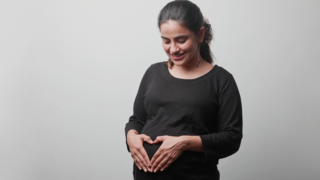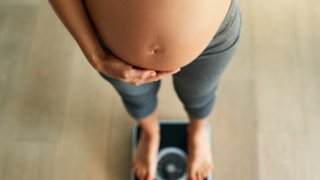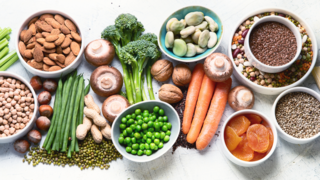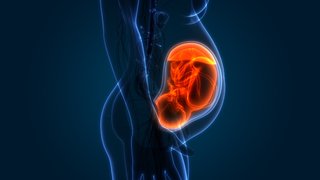
Week 38 of Pregnancy

Key Takeaways at Week 38
- Are you feeling the burn? Baby may be wreaking havoc on your digestive system, resulting in heartburn and reflux. Their accommodations are cramped, exerting strain on all of your organs. Perhaps avoid spicy foods, despite the old wives' belief that they may induce labour
- Diarrhoea is also frequent at this late point of pregnancy, as hormones prepare you for the big delivery!
- At this week's checkup, your obstetrician or midwife will examine you to see if you're dilated. In other words, they're feeling around to see if your cervix has thinned and opened up yet
- If you feel a lightning bolt-like sensation running up and down your legs (and in your vagina!), don't panic. At 38 weeks pregnant, the baby is most likely sitting low in your pelvis, which means they're coming into contact with a variety of nerves including some really sensitive ones you may not be aware of. The main event could take place today or in a few weeks. Until then, try to relax
- If you are in Week 38 of your pregnancy you are in the third trimester and in the ninth month
- 2 more weeks remaining in your pregnancy
Baby's Movement and Baby’s Development at Week 38
Your baby is still shedding lanugo, the fluffy hair that has been covering them since early in the second trimester. The intestines are gathering lanugo, dead skin cells, and digested amniotic fluid to form your baby's first stool. This waste, known as meconium, will seem tarry and greenish-black to whoever is on the initial nappy duty.All of your baby's sucking and swallowing is important preparation for eating after they are born. Your baby's muscles are also developing, allowing them to form facial expressions and interact with you and the people around them.
Your baby's lungs are developed enough to collaborate with the vocal cords to make their first cry, and then their second, and third!
- Baby Weight: Over 3 Kg
- Baby Length: Over 20-21 inches long
- Baby Size: Comparable to pumpkin
Can I deliver in 38 weeks?
Yes! Babies typically arrive on their own schedule, which can be several weeks early. However, at 38 weeks pregnant, you are still officially "early term," so don't rush to try to induce labour on your own. Baby often requires a little more time on the inside. However, at this stage, inducing labour may be medically required if you have a complication like preeclampsia or gestational diabetes, a uterine infection, or a placental issue. If you are pregnant with twins or are bleeding, your doctor may advise, "It's time!" This may cause concern in any expectant mother who thought she had two more weeks, but rest assured that everything will be well. We can never be completely prepared (unless you're one of those ladies who makes it to week 42), and you and your baby are in good hands while under the care of your OB and paediatrician.Baby Position at 38 Weeks
Your little superstar is about to roll and has most likely settled into the birthing position: head-down, facing your back, chin tucked, legs up by your ribs. However, some babies are still head-up at this stage, indicating that they are breech. This position can make vaginal birth challenging, but there are several things you and your doctor can do to assist your baby in changing positions before labour.Pregnancy Symptoms and Body Changes This Week
During this week, your body is dramatically changing. As your baby grows, so will you, and you may feel specific pregnancy symptoms throughout this period.Labour is most likely the first sign that comes to mind. Diarrhoea, nausea, mucus plug removal, bloody show, water breaking, and contractions are all signs of labour. Whether it's pain in the vagina, rectum, back, hips, or legs, you're likely to be suffering some aches and discomfort in the last few weeks. Your baby is resting on delicate nerves, and your ligaments are lax.
Hormones and stretched skin may cause itching in your tummy. Use moisturising lotions, stay hydrated, and avoid taking really hot baths or showers. Continue to be patient! Soon, you'll be hugging your cutie on their belly.
Your need to urinate frequently will persist as your baby lays on your bladder.
Puffiness is a normal occurrence during pregnancy. Oedema, or swelling of the hands, ankles, and feet caused by water retention and increased blood and fluid volume, is common. To assist in minimising swelling, you can drink plenty of fluids and eat potassium-rich meals. While most swelling is harmless, sudden swelling in the face, hands, or around the eyes may indicate a dangerous illness such as preeclampsia or deep vein thrombosis (DVD). If you observe any swelling that you are concerned about, contact your doctor.
Body Changes This week
You may have an overpowering desire to clean, cook, or organise. This nesting impulse is normal, so have fun with it. Just watch out not to push yourself too far.However, you may also feel weary. Leg cramps, heartburn, and back pain may be keeping you up at night. Try a few pregnancy sleep tactics like using a pregnancy pillow to help you get some quality sleep.
38-week Ultrasound
You are now seeing your OB on a weekly basis, therefore you will have an appointment this week. During these weekly checkups, your doctor will ensure that the baby is in a head-down position and that the head has moved down into the pelvis. Prepare for a pelvic exam, which will examine your cervix for dilation (opening) and effacement (thinning), both of which indicate that your body is preparing for labour. Unfortunately, there is no "normal" when it comes to predicting labour based on dilation or effacement; once you've begun, labour could begin hours or weeks later. Even if you aren't dilated, you could go into labour tomorrow. If your doctor wants a more in-depth look at the baby, they may arrange an ultrasound around this time to determine the baby's size. They may also request a biophysical profile, during which the baby's respiration, movement, muscle tone, heart rate, and amniotic fluid will be assessed. In some situations, the results of the biophysical profile may lead your doctor to deliver the baby before your due date.
Your Baby Bump at Week 38
Is 38 weeks pregnant full-term? You are very near! At 38 weeks pregnant, you are considered "early term." It's almost an in-between stage as you've passed preterm (before 37 weeks) but haven't yet reached full term (39 weeks). You're counting down the days!Signs of Labour at 38 weeks
At 38 weeks pregnant, indications of labour may appear. Some early symptoms that you'll go into labour soon are:- Mucus plug and/or bloody show: You may have a thick mucus-like discharge (the mucus plug) with a slight crimson hue. This is an indication that your cervix is beginning to dilate in preparation for birth
- Diarrhoea: Diarrhoea may not be the result of eating spicy food; it could be an indication that your body is producing labour hormones. It may be "go time" soon
- Nausea: The same is true for nausea. This isn't a measured symptom of labour, although some women say they felt sick right before it started
- Contractions: Contractions may be a regular part of your day, or you may not have noticed any yet. However, if your belly begins to tighten at regular intervals and does not stop, you are most likely in the early stages of labour. Contractions that are painful, closer than five minutes apart, and continue for more than two hours are most likely an indication that you are in labour and should go to the hospital!
- Backache: You may have had a sore back for weeks, but at 38 weeks pregnant, acute or sudden back pain may indicate back labour, so notify your doctor if you are having symptom
- Water breaks: If you feel a trickle of water, it indicates that the amniotic sac has ruptured and fluid is coming out. Labour normally begins soon after a woman's water breaks, so notify your doctor if you have this symptom
How Dilated Should I be at 38 Weeks?
Every expectant mother experiences something unique. Some women may not be dilated yet, while others may be just a centimetre or two. Your doctor will check on this during your weekly sessions. If you're 4 centimetres dilated, prepare to go into active labour!Tips for 38 Weeks Pregnant
It's almost time to go. Here's what you can do right now to give yourself some love.Your itching belly may be bothering you right now, so do anything you can to feel better. Applying a heavy-duty moisturiser, such as pure shea butter, can assist with dry, stretched skin, as can maintaining hydration with plenty of water.
Increase blood flow to minimise oedema while enjoying the fresh air and a lovely landscape. You'll soon be walking a pram in the park!
Stop, and smell the lavender: This aroma is known for its calming and relaxing characteristics, making it an excellent natural sleep aid. Diffuse lavender essential oil in your bedroom or make a room spray by diluting it with water.
To determine if you have Braxton Hicks contractions or the genuine thing, you must know when each contraction occurs and how long they persist. Braxton Hicks contractions are usually painless and stop. If your contractions continue to be painful, call your doctor!
- Schedule a prenatal visit
- Purchase last-minute items for your baby
- Stock your nappy station
- Finish setting up your nursing station
- Double-check all of your baby-related preparations
Frequently Asked Questions
- Why would my doctor suggest a biophysical profile?
A biophysical profile is a test that can be done in the third trimester to assess Baby's health. A biophysical profile has two components: a nonstress test and an ultrasound. It is not common; it is usually done when there are particular pregnancy risk factors or when there is a decrease in foetal activity. Common risk factors connected with biophysical profiles include hypertension, gestational diabetes, obesity, multiples, and other chronic health disorders. It may also be done if you do not experience labour by 42 weeks gestation. - Do I have to be induced if I'm having twins?
It is not required, but many women want to schedule an induction for twins so that their healthcare team is better prepared to handle multiple deliveries. If you're having a healthy pregnancy, your provider may let you go into labour naturally and try for a vaginal delivery for both babies; however, if they have any concerns about delivery (for example, if one or both babies are breech or share a placenta and amniotic sac), you may be scheduled for an induction, if not a C-section, to ensure your babies' safety.








